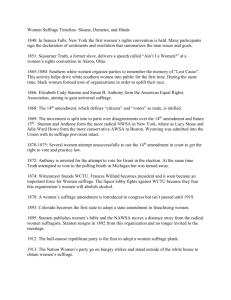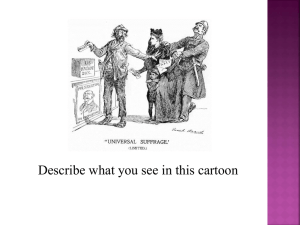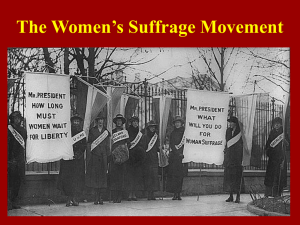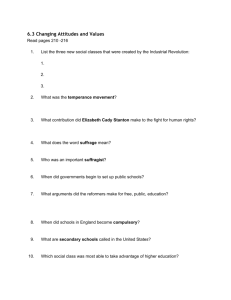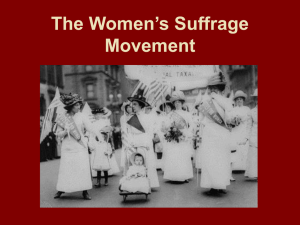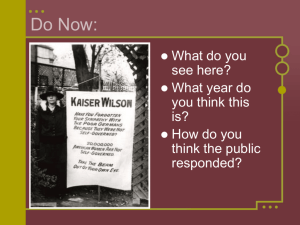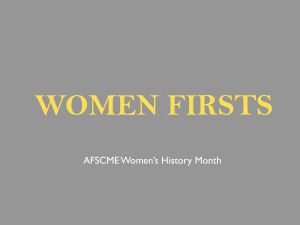7 Womens Movement
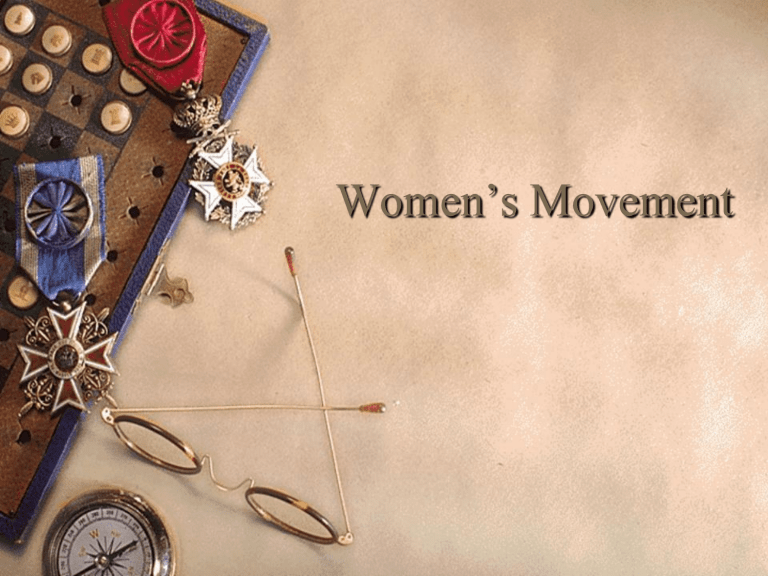
Women’s Movement
Women’s Movement in 1800s
Middle class women involved in reform to help poor, deaf, insane and victims of alcoholism
Many became active in abolition movement
Lucretia Mott, a Quaker involved in activities outside the home
Traveled in east and mid-west addressing reform organizations
1848 : The first women's rights convention in the United
States is held in Seneca Falls, New York. A "Declaration of Sentiments and Resolutions" is signed. Women's rights meetings are held on a regular basis after that.
1851: Sojourner Truth, a former slave, delivers her "Ain't
I a Woman?" speech at a women's rights convention in
Akron, Ohio
1859: Vulcanization of rubber provides women with reliable condoms for the first time in history. The birth rate in the United States continues its century-long downward spiral. By the late 1900s, women will raise an average of only two to three children, in contrast to the five or six children they raised at the beginning of the century
Mott went to London in 1840 as delegate to antislavery convention
Refused seating because she was a woman
Met Elizabeth Cady Stanton in England
Elizabeth Cady Stanton
Daughter of a wealthy judge in New York state
Married abolitionist Henry Brewer Stanton
Active in abolitionist movement
Spearheaded 1848 Seneca Falls
Convention
Declaration of Rights & Sentiments and 11 resolutions (right to vote)
Susan B. Anthony
Born in MA as daughter of mill owner, reformer and Quaker
Well educated, encouraged to express herself, became teacher
Became temperance leader in 1848 as a way to help women and children in homes where poverty and violence were prevalent
Collaboration
Anthony met Stanton in 1851 and began a longstanding collaboration
Stanton was initially teacher to Anthony
Stanton met family responsibilities (7 children) and did much writing
Anthony was powerhouse who spoke and crusaded
Married Women’s Property Act
Together fought for Married Women’s
Property Act in New York which gave married women rights to
– Own property
– Engage in business
– Manage their incomes
– Be joint guardians of their children
Together helped drive the movement to persuade Congress to pass 13 th
Amendment
1866 founded Equal Rights Association
Falling out with other abolitionists who wanted rights for freed slaves to be priority
1878 introduced Women’s Suffrage amendment
Continued work together concerning voting rights and other reforms
Stanton died in 1902 at age 87
Anthony died in 1906 at age 86
1920 19 th Amendment ratified
1912: Theodore Roosevelt's Progressive
Party becomes the first national political party to support suffrage for women.
Woodrow Wilson wins the election in 1913.
Protests continue despite pressure and arrests.
August 26, 1920: The Nineteenth
Amendment is ratified.
1923: The National Woman's Party proposes the Equal Rights Amendment to eliminate discrimination on the basis of gender.
Image courtesy of HBO films suffragette history website
March 3, 1913 -- the day before Woodrow Wilson's inauguration,
Inez Milholland, draped in flowing white robes leads a parade of an estimated 5,000 suffragists. This image became emblematic of the fight for women's rights in America. The marchers were attacked verbally and physically but refused to give up.
Image courtesy of HBO films suffragette history website
1917: (left to right) Doris Stevens, Mrs. J.A.H.
Hopkins, Eunice Dana Branham, in prison clothes.
The women were arrested for protesting in front of the White House for women’s suffrage.
Image courtesy of HBO films suffragette history website
Tennessee, 1920, Suffrage Ratification: (left to right) Banks Turner , whose vote prevented the tabling of the suffrage resolution ,
Catherine Flannagan, Anita Pollitzer, Harry Burn, who gave the last needed vote for ratification ; (in foreground): Thomas O. Simpson, who resisted "almost inhuman pressure of anti-suffrage interests," Betty
Gram, Sue White.
Image courtesy of HBO films suffragette history website

